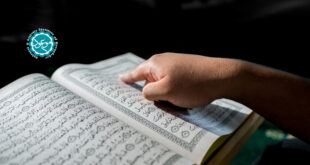Abu ‘Isa at-Tirmidhi, after narrating a Tradition in which it is said that Allah accepts alms (sadaqah) and takes it by His right hand, said:
More than one of the hadith scholars has said concerning this hadith and those like it which speak of His Attributes, and concerning the descent of Allah, blessed be He and Exalted, every night to the lowest heaven: ‘The narrations about this are confirmed, and must be believed in, but one should neither conceive nor ask the question “How?” ‘Similar reports are narrated from Malik ibn Anas, Sufyan ibn ‘Uyaynah, and ‘Abdullah ibn al-Mubarak, concerning these kinds of Traditions: ‘Act on them without [asking] how.’ And this is the opinion of the Sunni scholars. On the other hand, the Jahmiyyah denied the validity of these hadith, saying: ‘This is anthropomorphism.’
In several places in the Holy Qur’an, Allah, the Mighty, the Exalted, says: ‘hand’, ‘hearing’, ‘sight’, and the Jahmiyyah gave a linguistic interpretation (ta’wil) of these verses, and gave a different exegesis from that of the hadith scholars, saying: ‘Allah did not create by His hand; the meaning of ‘hand’ here being power (quwwah).’
Ishaq ibn Ibrahim:7 ‘There is only anthropomorphism when one says: “A hand like [another] hand, or similar to [another] hand; or hearing like [another] hearing, or similar to [another] hearing”, and when one says: “hearing like [another] hearing, or similar to [another] hearing”, this is anthropomorphism. But if one says, as Allah, the Exalted, said: “hand”, “hearing”, “sight”, and does not ask how, and does not say: “similar to [another] hearing” or: “like [another] hearing”, this is not anthropomorphism, and is like Allah, the Exalted, saying: There is nothing like unto Him; He is the All-hearing, the All-seeing.’8
From this it is clear that at-Tirmidhi was in agreement with this latter opinion.
2. Abu Bakr Muhammad ibn Ishaq ibn Khuzaymah as-Sulami an-Naysaburi (223/838–311/924), of whom it was said: He was the imam of Naysabur in his time, a faqih, a mujtahid, a sea among the seas of knowledge, whose advancement in science was recognized by all people of his period; as-Safadi, al-Yafi‘i, adh-Dhahabi, as-Subki, Ibnu ‘l-Jazari, as-Suyuti, and Ibn ‘Abdi ‘l-Hayy nicknamed him ‘imam of the imams’. ad-Dar Qutni said: “He was an imam without equal.” Ibn Kathir stated: “He is one of the mujtahids in the religion of Islam, and they say that he has miraculous powers (karamat).”
As-Sam‘ani stated: “Many [of the Traditionists] can be traced back to him, each one of whom was spoken of as a Khuzaymi [as he was the imam of a Traditionist school].” This is a small sample of what was said about him.9Ibn Khuzaymah asserted that Allah has a face. He said: “The meaning of this is not that His face is like a human face; otherwise anyone could say that humans had a face, and pigs, monkeys, and dogs, and so on, have faces, and that the faces of humans are like the faces of pigs, monkeys, and dogs . . .10
Similarly, he mentions the eye, the hand, the palm, and the right side, saying: “The eyes of Allah are unlike any other eyes.” He adds: We say that our Lord the Creator has two eyes, by which He can see that which lies beneath the ground and under the seventh and lowest earth, and that which is in the highest heavens, and all that lies in between . . . Let us add a commentary and explanation and say:
The eye of Allah is eternal and everlasting, and its strength continues for-ever, and is never destroyed or extinguished, while the eyes of human beings come into being; they did not exist and were not created, then Allah brought them into being and created them with His Word, which is one of His essential attributes . . .11
He states that Allah has two hands: ‘His two eternal hands are everlasting, while created hands come into being . . . What a comparison!’12 Interpretation is excluded from all this, especially the interpretation of His hands as Favour and Power.13
He mentions that:
The speech of our Lord does not resemble the speech of created beings, because the speech of Allah is unbroken, uninterrupted by a pause or mannerism, unlike the words of humans, which are broken by mannerisms and silences due to pauses [for breath], or reflection, or fatigue . . .14
3. ‘Uthman ibn Sa‘id, Abu Sa‘id ad-Darimi, at-Tamimi, as- Sijistani (c 199/815–280/894), al-Imam al-Hafiz al-Hujjah, a thorn in the flesh of the heretics, an upholder of the sunnah, trustworthy, established, an authority. It is said of him: He was an imam who was emulated during his life and after his death. The Shafi‘is mentioned him in their biographies, and the Hanbalis count him among the followers of Ibn Hanbal.15
Ad-Darimi stated that Allah has a place (makan), which he demarcated as the throne (al-‘arsh),16 and that He is clearly visible to His creation, above His throne in the atmosphere of the Afterlife, where there is no other creature, and no sky above Him.17 He said:
We have specified a single place for Him, the highest, purest, and most noble place: His mighty throne . . . above the seventh, highest heaven, where there are no men or jinn, no smoke, no toilet, and no devil. You [Bishr al- Marrisi]18 , along with the rest of your misguided colleagues, claim that He is in every place, in smoke, in the toilet, and next to every man and jinn! Is it you who anthropomorphize Him, when you speak of incarnation in places, or us?19
He said:
If Allah did not have hands with which to create Adam and touch him as you claimed, then it would not be possible to say [of Allah]: by Your gracious hand.20 Thus he ignored all meaning or explanation relating to Favour or Power, save for the two hands [for which there is a meaning, since they are the organs dedicated to sensation].21
Truly Allah has two fingers . . . and two legs; there is no other interpretation.22Although we do say, as Allah states:
The face of thy Lord remains (ar-Rahman, 55:27).
By this He meant the face that is turned towards the believers, and not good works, or the qiblah . . .23 The refutation of anthropomorphism is rather that Allah posesses all these, but that they are not analogous to created things.24
I have cited the above as specific examples of what has been stated about the non-Imami Traditionist school, and I shall not add anything to them, except what I consider necessary to note
in a very brief manner – regarding the intention of corporealism and anthropomorphism which is refuted of Allah, and which certain proofs have refuted. The real meaning of the doctrine of corporealism or what underpins it, such as limbs or bodily extremities, locality, and time, requires the comparison of Allah with created beings; anthropomorphism lies at the root of corporealism and its consequences, not in its typology or particularities.
The doctrine that Allah has a head or a stomach, for example – may Allah be raised above such things – requires corporealism, and leads in the end to Allah being comparable with created beings. Either His head or stomach are comparable to created heads or stomachs, or they do not resemble any of these heads or stomachs and are rather distinguished as a head which does not resemble any other, and a stomach which does not resemble any other, and so on for other things besides the head and the stomach.
With respect to the hadith which they pass on and maintain as true (the sources will be mentioned), ‘Allah created Adam in His own image’, according to those who explain it as the image of Allah, and another hadith, that Adam was created in the image of the Merciful (ar-Rahman), these do not refer to the belief that Allah has an image or a face, and that is all, but [to the belief] that His image and His face resemble the face and image of Adam and resemble man’s face and the image of him.
Comparison of the Imami and Non-Imami schools
For a comparison between the above and that which is associated with the Imamiyyah, the reader can refer to what I have written about the Imami Traditionists in what I have said concerning as-Saduq and al-I‘tiqadatu ‘l-Imamiyyah and his connection with al-Mufid and Tashihu ‘l-i‘tiqad. What follows is a discussion of the Hishamayn, [i.e.] Hisham ibn al-Hakam and Hisham ibn Salim, who were accused of corporealism and anthropomorphism. As for others besides them, and those whose names are mentioned alongside them, I do not deny that there were among the Imamiyyah those who spoke of determinism (jabr) and anthropomorphism, or who were accused of it, but these were very few.
It is natural, with respect to all sects, and in all intellectual and religious communities, for a member or members to deviate, to stand apart with ideas and convictions, which are at odds with the group they originate from. To judge the group itself by way of judgments drawn from the stance of these few is incorrect, unless they form the majority, or are prominent or predominate to the extent that they become representative of their sect, and a model for them.
Another example which underscores what I have said comes from a study of the commentaries on al-Kafi in what concerns the hadith on Unicity in Kitabu’t-Tawhid. Of the many com- mentaries of al-Kafi there are four, all in print, by four contemporaneous scholars. They are:-
1. Sadru’d-Din, Muhammad ibn Ibrahim ibn Yahya al-Qawami, ash-Shirazi, Sadru ‘l-Muta’allihin (979/1571–1050/1640): Sharhu’l-Kafi, dealing with what is contained in the first part of the Kitabu ‘l-Hujjah in the Usulu ‘l-Kafi.
2. Muhammad Salih ibn Ahmad al-Mazandarani (d. 1086/1675), the famous scholar and Traditionist: Sharh Usulu ‘l-Kafiwa ‘r-Rawdah.
3. al-Fayd al-Kashani, Muhammad Muhsin (1010/1599–1091/1690), in his comments on the hadith of al-Kafi on Unicity in his book al-Wafi.
4. al-‘Allamah al-Majlisi, Muhammad Baqir ibn Muhammad Taqi (1037/1628–1110/1699): Mir’atu ‘l-‘uqul, which comments extensively on al-Kafi.
These four differ with respect to their intellectual orientations, their knowledge of the sciences, and their specialization in its branches. Among them, one was considered an outstanding authority in Islamic philosophy, the master of one of its most famous schools, i.e., Sadru ‘l-Muta’allihin. Another was among those who stood between philosophy, fiqh, and hadith, i.e., al-Fayd, and the two others were largely concerned with hadith and its sciences, i.e., al-Majlisi and his brother-in-law al- Mazandarani.
A study of their commentaries and their concurrance on hadith transmitted from the Imams of the Ahlu ‘l- Bayt, peace be upon them, concerning Unicity and Justice should provide us with the strongest evidence for what I have stated about the Imamiyyah: that whatever the differences in their approaches their opinions about that which related to the fundamentals of the faith did not differ.
At the most basic level, the fundamental reason for this goes back to the nature of the Imami hadith itself, and the fact that they differ from non-Imami hadith. The hadith related by non- Imami sects – and I have listed the names of the books which refer to these hadith, and which treat of their explanations, and of the interpretations of those which require interpretation– do not contain a trace of anything that refutes corporealism, anthropomorphism, or determinism, while at the same time they abound in hadith which on the surface support corporealism, anthropomorphism, and determinism.
The interpreters could not find reliable hadith which explicitly refute anthropomorphism, thus enabling them to solve the problem by explicating hadith with hadith or by interpretating what appears to affirm it through that which textually negates it, so they were compelled to take refuge in other methods of interpretation.
This is clearly apparent in the works of Ibn Furak, al- Khattabi, and al-Bayhaqi – mentioned above – and also in what was written by Abu ‘l-Ma‘ali al-Juwayni, ‘Abdu ‘1-Malik ibn‘Abdillah an-Naysaburi ash-Shafi‘i (419/1028–478/1085), the famous Ash‘ari theologian, in his books on theology, and Fakhru ‘d-Din ar-Razi, Muhammad ibn ‘Umar ash-Shafi‘i (544/1150–606/1210), the imam of the theologians, the well-known Ash‘ari commentator, in his famous Commentary on the Holy Qur’an and in his books on theology.
It is also evident in the interpretations of Ibnu ‘l-Jawzi and Taqiyyu’d-Din al-Hisni, in their two books on religion mentioned previously. A study of these interpretations should provide the strongest proof of what we have said.
The situation with Imami hadith was the opposite of this. The hadith on Unicity are cited in the Kitabu ‘t-Tawhid in al- Kulayni’s al-Kafi, the Shaykh as-Saduq’s Kitabu ‘t-Tawhid, and the Kitabu ‘t-Tawhid wa ‘l-‘adl from the well-known encyclopedia of hadith, the ‘Allamah al-Majlisi’s Biharu ‘l-anwar. The latter contains all that was passed down in the Imami sources, whether it was firmly established or incompletely transmitted, whether its chain of authority was correct or incorrect, and is to be found in the modern edition in six sections (vols.3-8).
Whoever refers to them will find them without equal, for they are replete with sound hadith, one after the other, complete, and meaningful, which clearly prove the refutation of anthropomorphism, corporealism, and determinism, and which specifically prove the majority of what the Imamiyyah believe regarding Unicity and Justice, along with that which they share with other Muslims. For this reason, al-Kulayni and as-Saduq did not find any difficulty in demonstrating the falsity of these doctrines, except in the fact that they had to choose from an enormous number of hadith, which plainly and clearly demonstrated it.
Tags Imamiyyah
Check Also
15 European Countries With Most Muslims
According to Mouood, quoting by World Atlas: 15 European Countries With Most Muslims By 2050, Muslims …
 Mouood Mouood English Edition
Mouood Mouood English Edition



